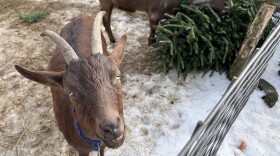The battlefield is ancient. Strewn with the debris of generations. Trees splintered, rocks shattered. Neither side will yield this talus slope in the pursuit of that which is most coveted. This is Game of Stones.
Actually, this is just another installment of New Hampshire’s Wild Neighborhoods, and this time we’re scaling the battle ground known as Talus. And there was some disagreement at Something Wild about whether we should call it “talus” or “talus woodland.”
What we did agree on was that when the ice-sheet receded from New Hampshire 12,000 years ago, it scraped up the landscape pretty significantly. In its wake it left south-facing cliffs, with boulder fields at their feet. Imagine Cannon Mountain in Franconia Notch or Cathedral Ledge in North Conway. And these boulder fields are the front lines of where the titans Geology and Botany clash.
The argument for calling this “talus woodland” is that over time, the boulder fields develop a mat of leaf litter, moss and soil that will catch seeds and over eventually develop into a forest. But that forest can only develop absent disturbances. This is a battle ground because the cliffs still contain unstable elements in the form of falling rocks. But rock, and more frequently ice, slides can devastate stands of tree-saplings. So that forest can only gain some ground when those disturbances are few and far between.
Either way we estimate there are probably close to a thousand talus sites in New Hampshire. And there’s more than just rocks at the base of those cliffs. There are a number of plants clinging to the rocks like Climbing false buckwheat – a scrappy vine with delicate white flowers; also the polypody – or many footed – fern, which wedges it’s many roots into any cracks in the rock it can to gain a toe-hold.
You’ll also find the black elderberry shrub with purple leaves and pick flowers, it’s a favorite among the porcupines, who also live in those rocks. These rock fields are like condos for porcupine; Condos that are passed down from generation to generation. You’ll find well-trod porcupine trails wending through the boulder field from their dens to their favorite feeding places. They are particularly fond of the elderberries and stag-horn sumac along the edge of the boulder field. You might not recognize them as tree, because they have been chewed and tortured by generations of porcupines into misshapen and stunted examples of the vegetation.
The legion nooks and crannies among the boulder field is prime denning ground for mammals of all sizes from chipmunks to bobcats. Some of our avian friends also make homes in this battle ground like turkey vultures will which lay their eggs among the rocks.
But just south of the of that boulder field, Birnam wood approaches Dunsinane Hill…the trees are soldiering ever forward. In fact, some have been soldiering along for quite some time. Because of the rocky and uneven terrain in talus slopes, the forests growing up around them are frequently inaccessible to us humans for harvesting or development. So it’s a place where you can sometimes find trees that date back hundreds of years.
While it may look like a bunch of rocks, talus is no less dynamic than all of New Hampshire’s other wild neighborhoods.









